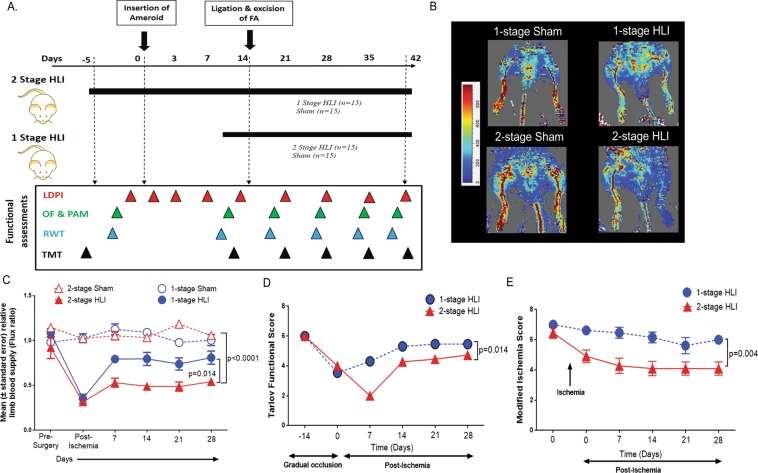Figure 1.
A surgically induced 2-stage HLI model showed reduced perfusion and functional score after ischemia induction compared to controls. (A) Schematic representation of the experiment and surgery showing the time points of various assessments; mainly Laser Doppler Perfusion Imaging (LDPI), Open field (OF), Pain application measurement (PAM), Running wheel test (RWT) and Treadmill test (TMT). (B) Representative LDPI images obtained 28 days after ischemia induction in mice undergoing the 1-stage and 2-stage Hind limb ischemia (HLI) models with their respective controls. (C) Quantitative image analysis showing the ratio of the ischemic to contralateral limb perfusion following different HLI models. The 2-stage HLI model displayed delayed restoration of perfusion compared to the 1-stage HLI model. Data shown as mean ± SEM and analysed by repeated measures 2-way ANOVA. (D) Graph showing Tarlov functional scores. The movement of animals were monitored and functional scores of the various groups were assessed according to the scoring criteria detailed in the materials and methods section. The 2-stage HLI model showed reduced function throughout the experimental period compared to the 1-stage HLI model. Data shown as mean ± SEM and analysed by repeated measures 2-way ANOVA, and p value significant at ≤0.05. (E) Graph showing modified ischemia scores. The animals were monitored and scored for signs of ischemia according to previously published criteria detailed in the materials and methods. The 2-stage HLI model showed a higher level of ischemia compared to the 1-stage HLI depicted by a lower scoring throughout the study period. Data shown as median ±SEM and analysed by repeated measures 2-way ANOVA, and p value significance set at ≤0.05.

